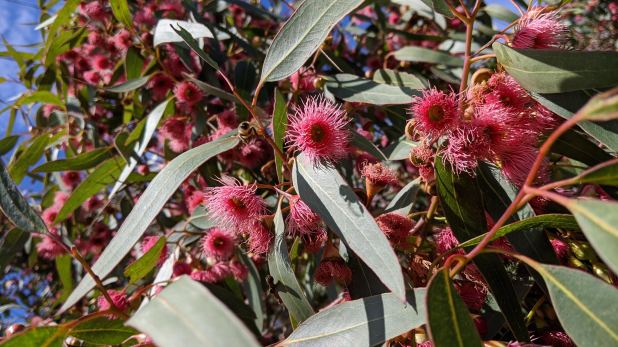Wild yeast hunting doesn’t always strike gold. Sometimes you end up capturing something that faithfully recreates the odours of vomit, or sweat, or cheese, or maybe all of them at once. Even if it’s disgusting, I still find it immensely fun to be hit with a surprise nostril assault and find the words to describe it.
In the interests of publishing negative results and sharing my yeast capture method, here’s the grotesque outcome of a recent attempt to capture brewing microbes from a Eucalypt blossom.
9 April 2020
The yellow gum (Eucalyptus leucoxylon) in my Melbourne front yard is currently going bonkers. Every day its teeming with lorikeets, bees, and flies, which I assume must be moving nectar-inhabiting microbes around, spiking the very open nectaries with potentially useful fermenters.

I clipped off several branchlets with fresh-looking flowers, and brought them inside, careful to not handle or touch the flowers I was going to use for capture. In my improvised biological safety cabinet (stove-top, gas hob on low, extraction fan on), I picked flowers off with flame-sterilized forceps and dumped them into four sterile jars of media, each jar had two flowers in about 80mL. All incubation took place in a warm spot above the heat lamp in the python’s tank. The jars probably cycle through swings from 10 – 25 degrees C.

Wild capture media (1 litre)
86g pils DME for a target 1.030
25mL EtOH for 2.5% abv
1 drop of tetrahop
Adjust pH down from 5.5 to 4.5 with 88% lactic using narrow range pH papers

18 April 2020
After just 9 days, there’s already a terrific pellicle growing on a couple of the jars. I removed the flowers from all of the jars with sterilized forceps, decanted some of the liquid, and topped up with fresh capture media.
My notes on appearance for the four jars below.
#1: Pellicle forming. Cloudy.
#2: Slightly cloudy, no pellicle.
#3: Robust pellicle. Cloudy.
#4: Very cloudy, no pellicle.

01 May 2020
By now, I should have cultured up the bugs that were going to grow, and filtered out the ones that can’t survive in the presence of low pH/alcohol/alpha acids. I swirled each sample jar and decanted a small amount into a fresh and sanitized 250mL flask to inoculate fresh 1.037 LDME wort within.
05 May 2020
I think #4 has possibly caught a Saccharomyces infection. Froth and bubbles present, but were not in the initial capture.
11 June 2020
Time to smell, taste, and measure. I decanted a 100mL sample from each flask, then replaced the volume with more fresh 1.037 DME wort.
#1: Thick mat of white mould on the surface. Discarded.
#2: Gravity is 1.024. 34% apparent attenuation.
Appearance: Solution is bright. Nothing in suspension. No pellicle.
Aroma: Smells of Eucalyptus oil (most likely still hanging around in solution after coming off the flower), heavily phenolic, smokey, leather, solventy like acetone or ethyl acetate. Then there’s a faint background sick and cheesy vibe. Just faint. The whole sample is very pungent. Aroma is overpowering, and not something I want to taste.
#3: Gravity is 1.024. 34% apparent attenuation.
Appearance: Cloudy yellow. Robust white pellicle.
Aroma: Smells sharply and impressively of sour sweaty feet, with a dash of body odour, and slightly like vomit. Could be isovaleric acid. I don’t like foot smell and I am not tasting it.
#4: Gravity is 1.015, so this one has achieved a reasonable 59% attenuation, which fits with the bubbling I noted on 5th May.
Appearance: Cloudy yellow. Rocky white pellicle…. and then I tried to decant the sample and boy was it thick and ropey. It has become sticky and glutinous like Chinese takeaway sweet-corn soup.
Aroma: Smells sort of intermediate to #2 and #3. It has the light Eucalyptus and smoke presence of #2, along with the vomit and cheese of #3. Again, I’m not putting this in my mouth.

10 July 2020
A last chance at redemption. Have any of these turned a corner and presented anything remotely appetising to warrant continuing the experiment?
#2 is dropping clear and bright. It smells phenolic, but there’s some fruitiness in there too! A white-wine like fruitiness. There’s also an enteric slightly vomity backdrop there. I dared to taste this one, just a small sip, then spit, and it does taste quite fruity too. Nothing fantastic, and the wort is still very sweet indicating no further attenuation.
#3 is hazy. Stills smells strongly of sour foot sweat. It’s going down the drain.
#4 is still grotesquely goopey and smells like it did one month ago. Kill it with fire.
Conclusion
My first attempt to capture an estate culture from my own small patch of suburban Melbourne has failed. Yet the impressive bouquet of bodily odours produced by these microbes was a fun display of nature in action.





